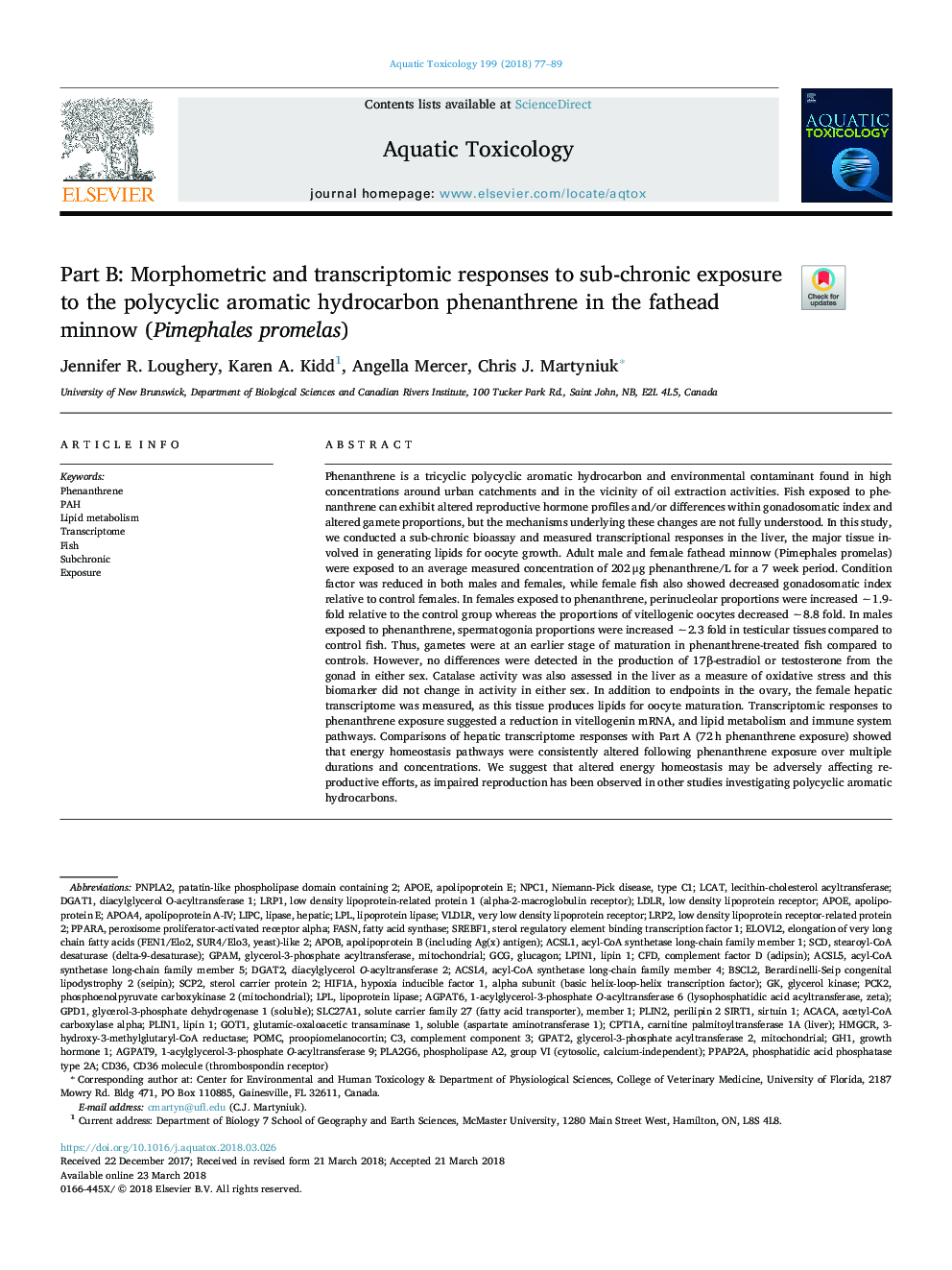| Article ID | Journal | Published Year | Pages | File Type |
|---|---|---|---|---|
| 8883737 | Aquatic Toxicology | 2018 | 13 Pages |
Abstract
Phenanthrene is a tricyclic polycyclic aromatic hydrocarbon and environmental contaminant found in high concentrations around urban catchments and in the vicinity of oil extraction activities. Fish exposed to phenanthrene can exhibit altered reproductive hormone profiles and/or differences within gonadosomatic index and altered gamete proportions, but the mechanisms underlying these changes are not fully understood. In this study, we conducted a sub-chronic bioassay and measured transcriptional responses in the liver, the major tissue involved in generating lipids for oocyte growth. Adult male and female fathead minnow (Pimephales promelas) were exposed to an average measured concentration of 202â¯Î¼g phenanthrene/L for a 7 week period. Condition factor was reduced in both males and females, while female fish also showed decreased gonadosomatic index relative to control females. In females exposed to phenanthrene, perinucleolar proportions were increased â¼1.9-fold relative to the control group whereas the proportions of vitellogenic oocytes decreased â¼8.8 fold. In males exposed to phenanthrene, spermatogonia proportions were increased â¼2.3 fold in testicular tissues compared to control fish. Thus, gametes were at an earlier stage of maturation in phenanthrene-treated fish compared to controls. However, no differences were detected in the production of 17β-estradiol or testosterone from the gonad in either sex. Catalase activity was also assessed in the liver as a measure of oxidative stress and this biomarker did not change in activity in either sex. In addition to endpoints in the ovary, the female hepatic transcriptome was measured, as this tissue produces lipids for oocyte maturation. Transcriptomic responses to phenanthrene exposure suggested a reduction in vitellogenin mRNA, and lipid metabolism and immune system pathways. Comparisons of hepatic transcriptome responses with Part A (72â¯h phenanthrene exposure) showed that energy homeostasis pathways were consistently altered following phenanthrene exposure over multiple durations and concentrations. We suggest that altered energy homeostasis may be adversely affecting reproductive efforts, as impaired reproduction has been observed in other studies investigating polycyclic aromatic hydrocarbons.
Keywords
DGAT2ELOVL2PNPLA2diacylglycerol O-acyltransferase 2SREBF1PLIN1LRP1apoBLPLDGAT1PLA2G6NPC1PPARALRP2ACSL5LCATACACAGH1APOA4GPAMGOT1acyl-CoA synthetase long-chain family member 1ACSL1PAHPCK2diacylglycerol o-acyltransferase 1SCDgpd1CD36SCP2HMGCRBscl2GCGLDLRacyl-CoA synthetase long-chain family member 4POMCCpt1aAcsl43-hydroxy-3-methylglutaryl-CoA reductasePLIN2HIF1aVLDLRperoxisome proliferator-activated receptor alphaApoeApolipoprotein A-IVapolipoprotein Eacetyl-CoA carboxylase alphafatty acid synthaseTranscriptomecomplement component 3ExposureCFDSubchronicsterol regulatory element binding transcription factor 1Fasnlecithin-cholesterol acyltransferaseLipcLipoprotein lipaseFishLipid metabolismpatatin-like phospholipase domain containing 2Sterol Carrier Protein 2proopiomelanocortinPhenanthreneGlucagonGlycerol kinaseVery low density lipoprotein receptorlow density lipoprotein receptor
Related Topics
Life Sciences
Agricultural and Biological Sciences
Aquatic Science
Authors
Jennifer R. Loughery, Karen A. Kidd, Angella Mercer, Chris J. Martyniuk,
